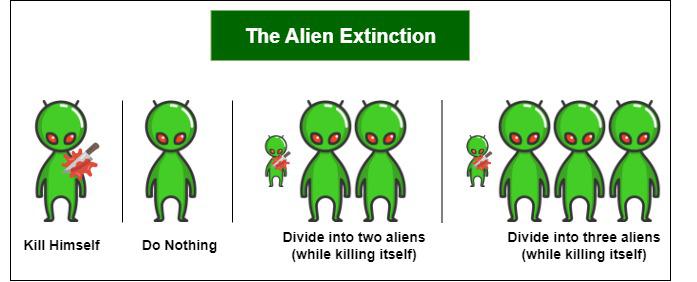Puzzle | The Alien Extinction Riddle
Last Updated :
20 Feb, 2023
An alien visits Earth one day. Each alien accomplishes one of the following four actions every day, with equal likelihood:
- Kill himself
- Do nothing
- Divide into two aliens (while killing itself)
- Divided itself into three aliens (while killing itself)
What is the probability that the alien species eventually die out entirely?

The Alien Extinction Riddle
Solution:
Suppose that the probability of aliens eventually dying out is x. Then for n aliens, the probability of eventually dying out is xn because we consider every alien as a separate colony. Now, if we compare aliens before and after the first day, we get:
- x = (1 /4) * 1 + (1 /4) * x + (1 /4) * x² + (1 /4) * x³
- x³ + x² − 3x + 1 = 0
- (x − 1)(x 2 + 2x − 1) = 0
We get, x = 1, −1 − √ 2, or − 1 + √ 2
We claim that x cannot be 1, which would mean that all aliens eventually die out. The number of aliens in the colony is, on average, multiplied by 0 + 1 + 2 + 3 + 4 = 1.5 every minute, which means in general the aliens do not die out. (A more rigorous line of reasoning is included below.) Because x is not negative, the only valid solution is x = √ 2 − 1.
To show that x cannot be 1, we show that it is at most √2 − 1.
- Let xn be the probability that a colony of one bacteria will die out after at most n minutes. Then, we get the relation:
- xn+ 1 = 1/4 (1 + xn + x²n + x²n)
- We claim that xn ≤ √ 2 − 1 for all n, which we will prove using induction.
- It is clear that x1 = 1 /4 ≤ √ 2 − 1. Now, assume xk ≤ √ 2 − 1 for some k. We have:
- xk+1 ≤ 1/4 (1 + xk + x²k + x³k) ≤ 1/4 ( 1 + (√ 2 − 1) + (√ 2 − 1)² + (√ 2 − 1)³ ) = √ 2 − 1
- Which completes the proof that xn ≤ √ 2 − 1 for all n. Now, we note that as n becomes large, xn approaches x.
Using formal notation, x = lim (n →∞) xn ≤ √ 2 − 1, so x cannot be 1.
Share your thoughts in the comments
Please Login to comment...